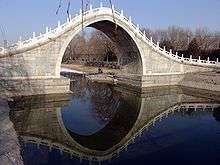Jade Belt Bridge
The Jade Belt Bridge (simplified Chinese: 玉带桥; traditional Chinese: 玉帶橋; pinyin: Yù Dài Qiáo), also known as the Camel's Back Bridge, is an 18th-century pedestrian moon bridge located on the grounds of the Summer Palace in Beijing, China. It is famous for its distinctive tall thin single arch.

The Jade Belt Bridge is the most well-known of the six bridges on the western shore of Kunming Lake. It was erected in the years 1751 to 1764, during the reign of the Qianlong Emperor, and was built in the style of the delicate bridges in the country-side of southern China. It is made from marble and other white stone. The ornate bridge railings are decorated with carvings of cranes and other animals. The clearance of the arch was chosen to accommodate the dragon boat of the Qianlong Emperor. As the Kunming Lake inlet to the neighboring Yu River, and when during special occasions, the emperors and empress and their dragon boat would specifically pass under this bridge. It is one of the most beautiful bridges in the Summer Palace.
Gallery
- Drawing by Charles W. Bartlett

 circa 1879
circa 1879 between circa 1900 and circa 1903
between circa 1900 and circa 1903 between 1870 and 1889
between 1870 and 1889 before or in 1902
before or in 1902 before 1906
before 1906_Sidney_D._Gamble_(RESTORED)_(4079128019).jpg) circa 1924
circa 1924
See also
- Precious Belt Bridge
- Chinese architecture
- Architecture of the Song Dynasty
| Wikimedia Commons has media related to Jade Belt Bridge. |